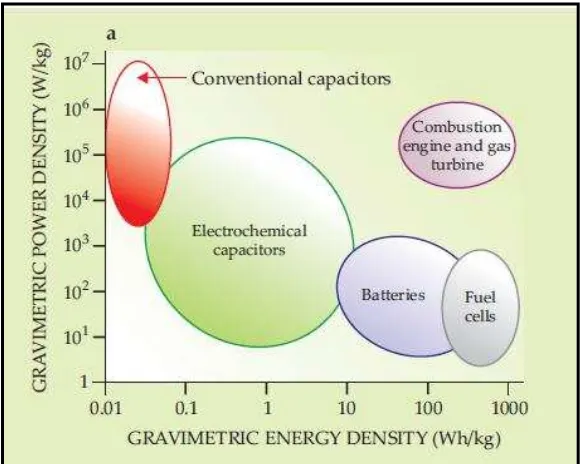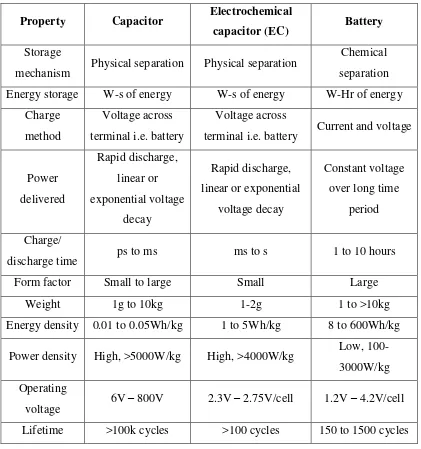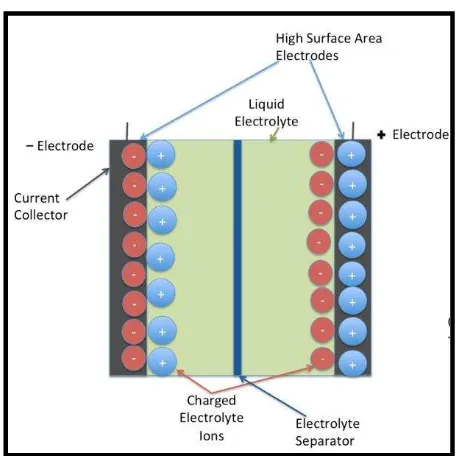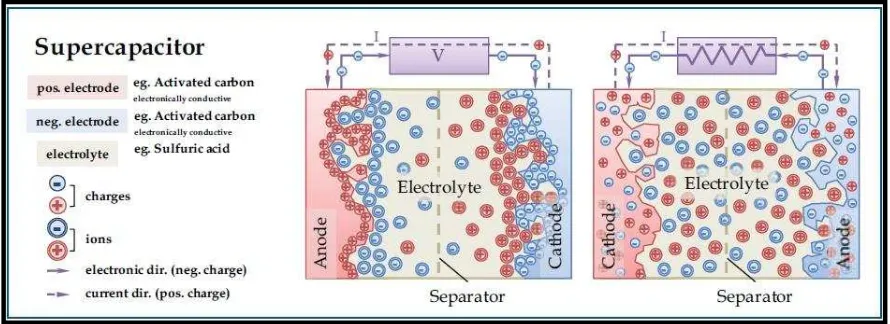UNIVERSITI TEKNIKAL MALAYSIA MELAKA
ACTIVATED CARBON AND GRAPHENE BASED ELECTROCHEMICAL
CAPASITOR IN AQUEOUS ELECTROLYTE
This report submitted in accordance with requirement of the Universiti Teknikal Malaysia Melaka (UTeM) for the Bachelor Degree of Manufacturing Engineering
(Engineering Materials)(Hons.)
by
NORASIMAH BINTI DORAH
B051010121
900515126096
DECLARATION
I hereby, declared this report entitled “Activated carbon and graphene based electrochemical capacitor in aqueous electrolyte ” is the results of my own
research except as cited in references.
Signature : ………..
APPROVAL
This report is submitted to the Faculty of Manufacturing Engineering of UTeM as a partial fulfillment of the requirements for the degree of Bachelor of Manufacturing Engineering (Engineering Material). The member of the supervisory is as follow:
………
i
ABSTRAK
Laporan ini membincangkan tentang kapasitan satu kapasitor elektrokimia (SPR) dengan menggunakan jenis yang sama bahan elektrod elektrolit tetapi berbeza. Penggunaan elektrod dalam eksperimen ini diaktifkan karbon dicampur dengan graphene. Terdapat dua elektrolit yang telah digunakan yang kalium hidroksida (KOH) dan asid sulfurik (H2SO4). Fabrikasi satu EC meningkatkan permintaan
ii
ABSTRACT
This report discuss about the capacitance of an electrochemical capacitor (EC) by using same type of electrode material but different electrolyte. The electrode use in this experiment is activated carbon mixed with graphene. There are two electrolytes that are being use which are potassium hydroxide (KOH) and sulphuric acid (H2SO4). The fabrication of an EC improves the demands in the usage of batteries
and capacitor. However, low energy density of EC limiting its application. Hence, researchers try to develop a better EC by increasing their surface area by using a porous material. Apart from that, previous researches found out that different electrolytes give out small effect in the capacitance of an EC. The method used in this report is solid state technique. The graphene was horizontally oriented and hence lowering down the specific capacitance (Csp) value. The specific capacitance value gained from the experiment was 13 F g-1 and 14 F g-1 in KOH and H2SO4 electrolytes
iii
DEDICATION
This report is dedicated to my parents (Mr Dorah bin Tajallah and Mdm Minah binti Amit) and my siblings (Mohd Asri, Hajmin, Mohd Romi, Lijawati, Norhasmi, Mohd
iv
ACKNOWLEDGEMENT
I would like to offer my unreserved gratitude and praises to Almighty Allah for His generous blessing and the undying strength bestowed upon me during the course of this research.
Special thanks to my supervisor, Dr. Mohd Asyadi Azam bin Mohd Abid who guide, assist and advise me all the way through this project.
Next, I want to thank my lovely parents whom with their prayers and moral support, I have gained strength to endure in this study.
Thank you very much also to my mentors and friends especially to Elyas bin Talib, Nor Syafira binti Abdul Manaf and Raja Noor Amalina binti Raja Seman.
Not forgotten, thank you to Tunku Ishak Tunku Kudin and Ainnur Sherene Kamisan from iMADE Lab, UiTM Shah Alam for their technical support and guidance throughout the experiment.
v
TABLE OF CONTENT
Abstrak i
Abstract ii
Dedication iii
Acknowledgement iv
Table of Content v
List of Tables viii List of Figures ix List of Abbreviations, Symbols and Nomenclatures xi
CHAPTER 1: INTRODUCTION 1
1.1 Background 2
1.1.2 Energy storage devices 2 1.2 Problem Statement 5
1.3 Objectives 6
vi
CHAPTER 2: LITERATURE REVIEW 7
2.1 Classification of electrochemical capacitor (EC) 7 2.2 Electrode materials 11 2.2.1 Electrochemical double layer capacitor (EDLC) 12 2.2.2 Pseudocapacitor 16 2.2.3 The composition of electrode materials 17
2.3 Electrolyte 18
2.3.1 Aqueous electrolyte 18 2.3.2 Non-aqueous electrolyte 19 2.4 Material Characterization 20 2.5 Energy dispersive x-ray (EDX) 21 2.6 Electrochemical performance 21 2.6.1 Cyclic voltammetry 21
CHAPTER 3: METHODOLOGY 23
3.1 Fabrication of carbon based EC 23 3.2 Electrode material preparation 24 3.2.1 Materials for EC fabrication 25 3.2.2 Equipment for EC fabrication 27 3.2.3 Experimental procedures 30 3.3 Fabrication process to produce EC 31 3.4 Set up for CV analysis 32
vii
3.6 Prototype development 35
CHAPTER 4: RESULT & DISCUSSION 37
4.1 EC fabrication process 37 4.2 Problem occurs in the experiment 41 4.2.1 Problem occurs in fabricating the electrodes 41 4.2.2 Problem occurs during testing the coin cell 42 4.3 Material characterization 43 4.4 Energy dispersive x-ray (EDX) performance 47 4.5 Electrochemical characterization 48 4.5.1 Performance of electrodes in 1M H2SO4 electrolyte 49
4.5.2 Performance of electrodes in 6M KOH electrolyte 52
CHAPTER 5: CONCLUSION & RECOMMENDATION 55
5.1 Conclusion 55
5.2 Recommendation 56
5.3 Future prospect 57
REFERENCES 58
viii
LIST OF TABLES
1.1 The differences between capacitor, electrochemical capacitor, and battery
4
2.1 Properties of various electrolytes 19 2.3 The difference in CV, SEV and EV vulcanisation systems 28
3.1 Material and its function 25 3.2
3.3
Apparatus and its function
Materials used and its weight percentage
27 31
4.1 The compositions of electrode and its Csp value 38 4.2 The composition of materials that gave out the highest specific
capacitance value
ix
LIST OF FIGURES
1.1 Ragone plot of power density versus energy density 3
2.1 Schematic diagram of EDLC 8 2.3 Different types of capacitive charge storage mechanism 11 2.4 3D diagram of graphene, graphite, carbon nanotube and
buckminsterfullerene
13
2.5 Schematic diagram of the pore sizes network of an activated carbon grain
14
2.6 SEM image of an activated carbon aerogel substrate prior to CNT growth
20
2.7 Cyclic voltammetry curve of activated carbon 22
x
3.6 Connected coin cell and LED in a larger amount 36
4.1 4.3 Corroded electrode 40 4.4 Slurry stuck in the mould 41 4.5 Coin cell burst open 42 4.6 The morphology of the electrode before (left) and after (right),
magnified into 500, 2000, and 5000x magnification
44
4.7 EDX graphs of electrode before and after immersed in the electrolyte 4.12 CV curve of scan rate at 1mV/s in KOHelectrolyte with different
scan rate
52
4.13 CV curve of activated carbon mixed with graphene in 6M KOH with different scan rate
xi
LIST OF ABBREVIATIONS, SYMBOLS AND
NOMENCLATURE
AC - Activated carbon C4H603 - Propylene carbonate
C2H3N - Acetonitrile
CV - Cyclic voltammetry CNT - Carbon nanotube
Csp - Specific capacitance value EC - Electrochemical capacitor
EDLC - Electrochemical double layer capacitor EDX - Energy dispersive x-ray
G - Graphene H2SO4 - Sulphuric acid
KOH - Potassium hydroxide NMP - N-methylpyrrolidinone OLC - Onion-like carbon PF - Phenol-furfural
1
CHAPTER 1
INTRODUCTION
This chapter discusses about the background and the different types of electrochemical capacitor (ECs) that exist. The types of each energy storage device are compared as long as its working mechanism which will be discussed in Chapter 2. The limitations of the batteries and conventional capacitors are brought upon and the advantages of EC are being explained.
1.1 Background
2
Kim, 2012). As for today, the three major commercialized energy storage devices are capacitors, batteries and fuel cells. To illustrate the advantage of ECs, the structure, mechanism and performance comparison of those devices are discussed in the following sections of this chapter.
1.1.2 Energy storage devices
Basically, energy storage devices can be classified into three parts which are Pconventional capacitors, ECs, and batteries. Conventional capacitors are defined as fundamental electric circuit elements that store electrical energy in microfarads and assist in filtering. It varies in terms of shape and size but possesses similar basic configuration. Capacitor consists of two conductors carrying equal but opposite charges. There are many important applications for capacitor in electronics field including storing electric potential energy, delaying voltage changes when coupled with resistors, filtering out unwanted frequency signals, forming resonant circuits and making frequency dependent and independent voltage dividers when combined with resistors.
3
The working principle of batteries is based on the chemical separation. Due to this principle, it possesses chemical reaction that limits its life cycles. Generally battery consists of two unlike metals or conducting substances (electrodes) that are placed in a liquid which causes a greater chemical change in one of the electrode than in the other. Hence, an electrical pressure or electromotive force is caused to exist between the two electrodes. The greater the difference in the chemical action on the electrodes, the greater will be the electrical pressure. By connecting wires or any electrical conductor to the terminals of the battery, an electric current will flow through the path or circuit. As the current flows though the system, one or both electrodes will undergo chemical changes and it will continue to flow until one or both electrodes change entirely.
Figure 1.1 shows the ragone plot for power and energy densities of conventional capacitors, electrochemical capacitors (ECs) and batteries. From the figure below, conventional capacitors have higher power density compared to ECs and batteries. Meanwhile, batteries have higher energy density compared conventional capacitors and ECs. However, ECs possess medium power density and energy density, and hence filling the gap between conventional capacitors and batteries.
4
Table 1.1 shows the differences between battery and EC. Battery and EC are different in power limitation, storage mechanism, energy limitation, charge rate, output voltage, life limitation and even in their cycle life limitation. Battery is used in conventional applications due to its high energy. Unlike battery, EC has a higher power density with longer cycle life time. Recent efforts have been focused on the development of EC that has high power density in order to have a better performance and to be used in a high demand application.
Table 1.1: The differences between capacitor, electrochemical capacitor, and battery (Steve Knoth, 2010).
Property Capacitor Electrochemical
capacitor (EC) Battery
Storage
mechanism Physical separation Physical separation
Chemical
terminal i.e. battery Current and voltage
Power
Power density High, >5000W/kg High, >4000W/kg Low, 100-3000W/kg Operating
5
1.2 Problem statement
The study of conventional capacitors to replace batteries has been widely focused into supercapacitosr which also known as ultracapacitors or in this study as electrochemical capacitors (ECs). ECs possess remarkable property as it fills the gap between conventional capacitors and batteries. Batteries have been used in conventional application and conventional capacitors are applied on electronic devices replacing batteries. However, the applications of conventional capacitors are restricted by its low energy density. ECs have more power density than batteries but low energy density. Hence, researchers are trying to overcome this problem by varying the materials used as electrode to achieve a better performance. This study will cover the effect of mixing activated carbon (AC) with graphene (G) as electrode in two different aqueous electrolytes which are potassium hydroxide (KOH) and sulphuric acid (H2SO4) on specific capacitance. In order to do so, basic
6
1.3 Objective
The objectives of this research project are:
1. To fabricate the electrochemical capacitor by using activated carbon mixed with graphene as electrode material in aqueous electrolytes.
2. To analyze the fabricated electrochemical capacitor by using cyclic voltammetry (CV) analysis in aqueous electrolytes.
1.4 Scope
This experiment had used activated carbon and graphene as electrode and KOH and H2SO4 as electrolyte. Note that 6M of KOH and 1M H2SO4 were used in this
7
CHAPTER 2
LITERATURE REVIEW
This chapter discusses the three types of ECs that exist. The working principles of each EC are also explained. Nonetheless, this topic is focusing more on EDLC and the types of electrolyte that are being used in the experiment. Apart from that, the material characterization and electrochemical performance that were used to test the fabricated EC are also discussed in this chapter.
2.1 Classification of electrochemical capacitor (EC)
8
electrode/electrolyte interface of high surface area (activated carbon). ECs stores electrical energy like conventional capacitor which is based on the separation of the positive and negative phase inside its interface.
The working principle of EDLC is based on the interface between electrode and electrolyte. Inside EDLC, there are two terminals that are separated by a dielectric or separator. This dielectric can be any kind of material that does not conduct electricity. The dielectric works as a separator between the two terminals to prevent any short circuit. Once these two materials come in contact with each other, the negative and positive poles are distributed over an extremely short distance. This phenomenon is called electrochemical double layer. Figure 2.1 below shows the schematic diagram of an EDLC.
Figure 2.1: Schematic diagram of EDLC (Aslani, 2012)
9
considered as self-discharge reaction of EC. The effect of this insignificant reaction is the accumulated charges cross the interface will be consumed in those reactions, and the total amount of the charges in the double layer will decrease. Therefore, the side reaction of Faradic that are mostly the redox impurities in the solution should be avoided.
Stern in 1924 has discovered that charges can form a double layer when it is separated, cross a conductor and a liquid electrolyte. Interface models had been establish to further explain about the phenomenon of the double layer. Qu in1998 indicates from the models, when DC voltage is introduced to the interface of an electrode, electric double-layer is then begun to store electric energy. Figure 2.2 shows a schematic diagram of an EDLC in charging and discharging states.
Figure 2.2: Schematic diagram of an electrochemical double layer capacitor showing charging (left) and discharging (right) (Source: <http://www.netl.doe.gov>09/12/13)
Some application of EC is to modify the rate of response of other components to improve the transfer of actual power to a load and to stabilize the frequency response
of circuits. EC’s ability to store charge makes them a critical component in a circuit
10
The relationship between the amounts of energy stored (Q) in an EC, the voltage applied (V) to drive the charge onto the plates of the EC, and the capacitance (C) is given below;
Q=CV (Eq. 2.1) Helmholtz explains that the capacitance per unit area of an EC is determined by the distance between the parallel plates and the dielectric constant of a material between the plates. These parameters can be translated into;
Eq. (2.2)
Where ɛr is the relative dielectric constant of the material between the plates, ɛo is the
vacuum permeability, A is the cross-sectional area of the plates, and d is the distance between plates.
In contrast to EDLC where the charge is stored electrostatically at the interfaces of the electrodes, pseudocapacitor stored charge through redox process at the electrodes surface. This process originally comes from faradic process since it involves electron transfer across the double layer at the electrode/electrolyte interfaces (John, 2009). Pseudocapacitance is produced by the faradic charge transfer from species adsorbed ineffective contact with the electrode surface or forming the electrode surface. The charge storage possess by this mechanism is approximately one order of magnitude higher than EDLC mechanism (Conway, 1999). However, when the electrostatic stresses are produced by charge transfer and built up of charge on the surface, it will lead to the mechanical strain within the electrode that will decrease the charge storage capacity. Pseudocapacitors lose capacity much more rapidly than EDLC. High charge and discharge rate also can produce extra stress that will shorter the device lifetimes. In principle, pseudocapacitance is controlled by thermodynamics, where the amount of charge accumulation (∆Q) from faradic charge transfer



